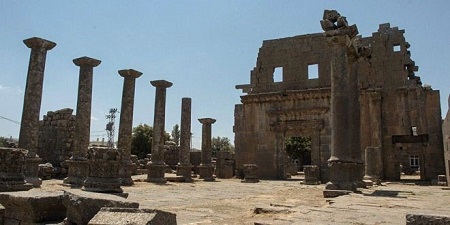Sweida, (ST) -The ancient temples in the town of Qanawat, located 7 km east of the city of Sweida, are a unique architectural example and a vivid witness to the region’s civilization and culture. The five temples in the Qanawat, which was called Qanatha in the past, are considered an important part of the archaeological sites in the town and one of the ten ancient Roman cities (Dikapolis), which is a group established by the emperor Bambi who was making a complex of commercial cities scattered in Jordan, Syria and Palestine.
The head of the Department of Antiquities, pointed out that the town of Qanawat is one of the oldest archaeological cities in the province inhabited by humans in prehistoric times and played an important role in the different historical ages during the Nabataean, Roman and Byzantine periods and occupied a distinguished position as a religious center of the southern region during the Roman period.
The town occupied a privileged position as a religious enter for the southern region during the Roman period and it is considered an archaeological testimony to the diversity of nature and ancient monuments of historical old buildings scattered across that was built of basalt stones monuments and covered arch and stone columns.
The most prominent monuments are five temples which included the temple of Helios and was dedicated to the worship of the goddess of the sun and dates back to the second century AD and its ruins could be seen on the southern side of the old town. There are six columns n the front of the entrance of the temple and there are crowns decorated with wreaths of Corinthian-style and Zeus Temple, the Goddess of Heavens, which is located in the southern part of the ancient city and dates back to the second century AD. The temple of Athena, the Goddess of wisdom, is located among a group of churches and four columns of Corinthian columns that date back to the second century AD are still existed.
Archaeological temples in the town of Qanwat also include the temple of the goddesses of water, which dates back to the second half of the 3rd century AD and is located within the valley of the town to the east of the wall of the old town. The temple was dedicated to the worship of the goddesses of water. It has eight niches. The he Ud Yun temple, which dates back to the second half of the 3rd century AD, has a small theater located on the eastern bank of Qanawat valley and to the north of the temple of the goddesses of water. Nine steps, some of which are carved into rock are still existed.
The town of Qanawat has a large number of archaeological sites including Churches dating back to the 4th century AD and the ancient baths that date back to the beginning of the second century AD.
It is noteworthy that the town of Qanawat, which is about 1250 meters above sea level is a tourist area and a beautiful resort because of the beautiful nature, the fresh air in addition to the spread of forest trees and vineyards apples and grapes.
Sharif al -Khatib

